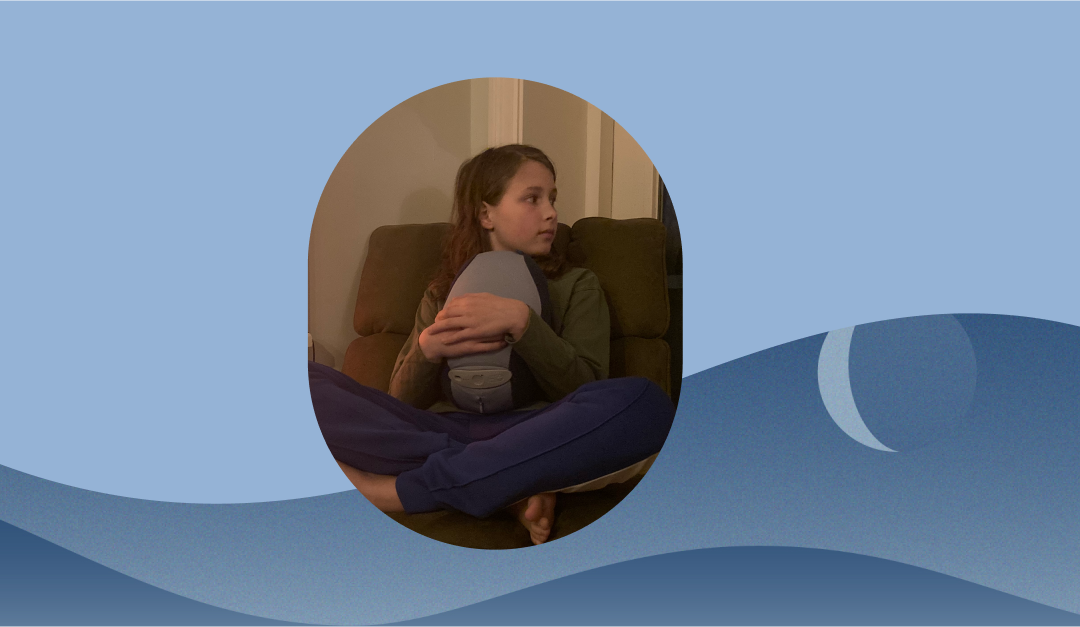
by Baginda Tirtadji | Monday, April 25, 2022 | Breathing, Research
Let’s face it: life can be taxing, especially these days. As a result, more people than ever are struggling with stress, anxiety, and insomnia.
When you’re feeling overwhelmed or restless, your breath is probably one of the last things on your mind. What most people don’t realize is that your breath is one of the most powerful tools you have to soothe your tense mind and body.
By performing simple breathing exercises, you can reduce stress, quell anxiety, and encourage restful sleep. We’ll be sharing five effective breathing exercises in this article, but first, let’s review some basics about stress, anxiety, and insomnia.
What are stress, anxiety, and insomnia and how are they related?
Stress is a normal part of the human experience. In fact, the human body is evolutionarily designed to react to stressful situations. When you experience challenges (stressors), your body produces short-term changes, such as increased heart rate, rapid breathing, extra oxygen to the brain (which increases alertness), sharper senses (like sight and hearing), and blood sugar release to supply energy to important parts of the body. Collectively, these symptoms are what we call “stress.”
Stress helps keep you alert, motivated, and ready to avoid danger, but it can become a problem when stressors continue without relief or relaxation.
Anxiety is similar to stress, but there is a distinct difference. Stress is usually caused by an external trigger, such as an argument with your spouse or a work deadline, while anxiety is defined by persistent, excessive worries that don’t go away even in the absence of a stressor. Anxiety, however, is often initially triggered by short-term or long-term stress.
Insomnia is a sleep disorder that can make it difficult to fall asleep, difficult to stay asleep, or cause a person to wake up too early and not be able to get back to sleep. A person is said to have insomnia if sleep problems occur at least three times a week for three months or longer. Insomnia has many potential causes, but is often the result of stress and anxiety. Conversely, ongoing insomnia can cause stress and anxiety.
As you can see, these three conditions are connected and ultimately stem from the same cause: an unbalanced autonomic nervous system.
Diaphragmatic breathing is an effective remedy to this unbalance. It increases the activity of your parasympathetic nervous system, which controls your rest-and-digest response. At the same time, it reduces the activity of your sympathetic nervous system, which controls your fight-or-flight response. As a result, you’ll experience reduced feelings of stress and anxiety and, consequently, an improved ability to fall and stay asleep.[*][*]
Easy Breathing Exercises for Stress, Anxiety, and Insomnia
Breathing is a mostly unconscious process, however, you can consciously change your breathing rate to calm your mind and body. We’ve rounded up five simple breathing exercises that you can use to weather stormy seas and harness your zen.
1. Box Breathing
Also known as square breathing, box breathing is very simple to learn, remember, and practice. Don’t underestimate the simplicity of this exercise—it’s a powerful way to induce relaxation. It’s even used by United States Navy SEALs to reduce stress and anxiety.
To practice box breathing, simply follow these steps:
- Exhale slowly, releasing all the air from your lungs.
- Breathe in through your nose as you slowly count to four in your head.
- Hold your breath for a count of four.
- Exhale for a count of four.
- Hold your breath for a count of four.
- Repeat steps 2-5 for four rounds, or until you feel relaxed.
2. Mantra Breathing
Synchronizing your breath with a mantra—a repeated sound or word—can help you sharpen your focus and relax an overactive mind. For this exercise, choose a word that makes you feel at ease, such as “peace,” “relax,” “or “calm.”
To practice mantra breathing, simply follow these steps:
- Establish a slow, diaphragmatic breathing pattern for about a minute.
- As you exhale, say your chosen mantra out loud.
- As you inhale, say your mantra quietly in your mind.
- Continue until you embody your chosen word.
3. 4-7-8 Breathing
Developed by Harvard-trained integrative medicine expert, Dr. Andrew Weil, the 4-7-8 method is a breathing technique adopted from the yogic practice of pranayama, meaning “regulation of breath.” Dr. Weil refers to this exercise as a “natural tranquilizer for the nervous system.”
To practice 4-7-8 breathing, simply follow these steps:
- Making a “whoosh” sound, exhale completely through your mouth.
- Keeping your mouth closed, inhale deeply through your nose for a count of four, allowing your stomach to expand.
- Hold your breath for a count of seven.
- Exhale through your mouth for a count of eight with a “whoosh” sound.
- Repeat this cycle about four times or until you feel relaxed.
4. Lion’s Breath Breathing
You might feel a bit silly while practicing lion’s breath, but this breathing exercise is very effective for relaxing the muscles in your face and jaw and alleviating stress.
This exercise is best performed in a seated position, leaning forward slightly with your hands on your knees or the floor.
To practice lion’s breath breathing, simply follow these steps:
- Spread your fingers as wide as possible.
- Inhale deeply through your nose.
- During the exhale, open your mouth as wide as you can, stick out your tongue, and stretch it down toward your chin as far as it will go. On the exhale, make a “ha” sound.
- Relax your face and breathe normally for a few seconds.
- Repeat lion’s breath up to six times.
5. Diaphragmatic Breathing with Somnox
Somnox is a jelly-bean-shaped companion that uses robotic technology to help calm your nervous system, thereby reducing stress and anxiety and helping you fall asleep faster, sleep deeper, and wake up refreshed. This science-backed robot expands and deflates as if it’s taking relaxing, diaphragmatic belly breaths.
Simply holding the robot, unconsciously encourages you to adopt the same slower-paced breathing rhythm. This stimulates the parasympathetic nervous system, which relaxes your nerves and puts you in a more conducive state for sleep.
To use Somnox for anxiety reduction or improved sleep, follow these steps:
- Hold Somnox 2 and turn it on. Within minutes, you’ll subconsciously adopt its calm breathing pattern.
- Smart sensors respond to your breathing in real-time, matching your rhythm and gradually adjusting it to the ideal rate.
- Let relaxation wash over you.
- If you’re using it for sleep, continue deeply breathing until you fall asleep. With the help of Somnox 2, you’re sure to fall asleep quickly, stay asleep, and wake up feeling rested.
Seventy percent of Somnox users report improved sleep quality within four weeks. Wondering if Somnox is right for you? Take our online sleep test to find out.
Break the Cycle of Stress, Anxiety, and Insomnia
Feelings of stress and anxiety and occasional sleeplessness are a part of our everyday lives. However, instead of allowing them to worsen, become chronic, or consume you, reach for effective tools like diaphragmatic breathing to soothe your mind and body
The next time you find yourself in choppy waters, remember these breathing exercises. They may seem simple, but they’re incredibly powerful and effective.

by Baginda Tirtadji | Thursday, April 14, 2022 | Breathing, Research
Many Americans experience considerable stress, according to the Stress in America 2020 Survey. In a stressed state, you may experience difficulty relaxing during the day and falling asleep at night. After a bad night’s sleep, you wake up tired, experience low energy and may have a bad mood. This can in turn contribute to trouble sleeping. A vicious cycle exists of stress and bad sleep, which can lead to chronic sleep problems. Patrick McKeown explains how breathing calms the mind and body, and how you can break this vicious cycle.
How can we break the vicious cycle of stress and bad sleep?
To break this vicious cycle, you will need to lower overall stress levels and experience more moments of relaxation during the day. According to Patrick McKeown, breathing is a tool to establish a more relaxed state. Patrick: “Breathing can bring calmness into the body and mind. To launch your body’s relaxation response, you will need to change your breathing pattern.”
“Breathing can bring calmness into the body and mind”
How should we breathe to launch the body’s relaxation response?
Patrick: “If you are stressed and have an agitated mind, you can experience faster and shallow breathing. For relaxation, you need to breathe slowly, low and through the nose.”
- Slow down the exhalation. During exhalation, the Vagus Nerve kicks in. This nerve is responsible for your relaxation response. A breathing rate of 4.5 – 6.5 breaths per minute is optimal to stimulate the Vagus Nerve. So take a soft breath in and slowly breathe out for relaxation.
- Breathe low in your belly, using the diaphragm. Simply put your hands on either side of your lower ribs. As you breathe in, you will feel the ribs gently moving out, as you breathe out, you will feel them moving in. If you place Somnox 2 Breathe & Sleep Companion on your belly, it can help you breathe slowly and bring your awareness to abdominal breathing to encourage low breathing.
- Always breathe through your nose. If you breathe through your nose, the air is prepared to be easily transferred from the lungs to the bloodstream. The mouth does not have any added value to your breath.
“For relaxation, you need to breathe slow, low and through the nose”
In the table below you find the differences between stressed and relaxed breathing.
| Stressed breathing pattern | Relaxed controlled breathing pattern |
| Fast breathing | Slow breathing (4.5 – 6.5 breaths per minute) |
| Upper chest breathing | Diaphragmatic breathing |
| Mouth breathing with sighs | Nose breathing |
What breathing exercise can relieve stress?
Patrick: “Slow exhalation helps combat stress by shifting your attention from the stressful situation to your breathing. With this breathing exercise, you help the brain interpret the stressful situation as a safe situation.”
- Put your hands on either side of your lower ribs
- Breathe in through your nose for four seconds
- Breathe out through your nose for six seconds
- Continue until you feel more calm
How can we use breathing to fall asleep more easily?
Patrick McKeown recommends practicing slow breathing before going to bed: “Before bed, practice slow breathing for 10 to 15 minutes. Take a very soft gentle breath in through your nose, and allow a relaxed and slow breath out. You should not hear yourself breathing, so take very light and slow breaths. The volume of air you breathe should be less than what you normally breathe. This will create a feeling of air hunger. The goal of the exercise is to feel that you would like to take in a deeper breath. This type of breathing activates the body’s relaxation response plus your mind is less likely to wander while focusing on your breath.”
“Before bed, practice slow breathing for 10 to 15 minutes”
Do you have any other breathing tips to improve sleep?
Patrick: “For healthy breathing, your bedroom should be airy, cool and dust-free. Also, train to rest your tongue on the roof of your mouth. This may help prevent sleep apnea, which can disturb your sleep. If you wake up with a moist mouth, you are breathing well for sleep.”
How does Somnox contribute to relaxation and better sleep?
Patrick: “Many people experience over stimulation of the mind during the day and struggle to down regulate the mind before sleep. With Somnox, an individual can shift attention from the mind onto the Breathe & Sleep Robot and do guided breathing exercises to calm the mind. Somnox can be part of an evening routine that helps individuals to fall asleep more readily.”
“With Somnox, an individual can shift attention from the mind onto the Breathe & Sleep Robot and do guided breathing exercises to calm the mind”
Patrick: “Another benefit of Somnox is that you can tailor the breathing to your own breathing. Someone who experiences anxiety and has fast upper chest breathing might find it too difficult to slow down to six breaths per minute. Whereas, if you told this person to slow down the breathing just a little more, this is easier.”
“Another benefit of Somnox is that you can tailor the breathing to your own breathing”
Patrick: “Further, if you hug something, the Vagus Nerve is stimulated, which helps you relax. Somnox can be your companion through the night as it breathes with you.”
“Somnox can be your companion through the night as it breathes with you”
For anyone looking to improve their sleep, Somnox 2 is your science-backed sleep companion that guides you towards slow-paced breathing that helps you fall asleep faster, worry less and wake up rested. 70% of our users improved their sleep quality within 4 weeks.

by Baginda Tirtadji | Wednesday, April 6, 2022 | Breathing, Research
Most of us have never regretted pausing for a moment to take a deep breath. Breathing deeply relaxes your body and mind, helping you to feel calmer and more in control.
You tend to feel better after a deep breath because your breathing affects your nervous system. The nervous system is like your body’s computer programming. It controls how you think, feel, and move your body. It also controls organs you don’t have to think about, like your beating heart.
Deep breathing has been found to help you feel more relaxed, think more clearly, and lift your mood.[*] Let’s break down how deep breathing leads to changes in the nervous system and why it’s so important.
Deep Breathing 101
Deep breathing refers to focusing your attention on taking slow, deep breaths. It’s common to spend much of your day using only shallow breathing. Shallow breaths tend to be rapid and only use a small percentage of your lung capacity. You know you are breathing shallowly when only your chest moves with each breath.
When you breathe deeply, you use a muscle under your lungs known as the diaphragm.[*] During a deep breath, the diaphragm contracts and moves down to make room for the lungs to fill. When you breathe out, the diaphragm relaxes and moves back up. You know you are breathing deeply when both your chest and belly expand and contract with your breathing.
Deep Breathing and Your Nervous System
Deep breathing promotes relaxation in the body because it helps to regulate the nervous system.[*] Each time you take a deep breath, your diaphragm contracts, and this contraction stimulates a part of the nervous system known as the vagus nerve.[*]
The vagus nerve is a system of nerves that run from the brain down to the large intestine. These nerves control involuntary actions in the body. Involuntary actions refer to bodily functions that happen without thinking about them, such as your heart pumping blood to the body or your digestive tract digesting your last meal.[*]
The vagus nerve is an important part of the nervous system because it helps to regulate the sympathetic nervous system. This system is known for its “fight or flight” response. When the sympathetic nervous system is activated, it causes an increased heart rate, breathing rate, and blood pressure. It can also lead to feelings of irritability and anxiety.[*] You likely felt your sympathetic nervous system activated the last time you had to do something stressful, such as giving an important presentation at work.
The vagus nerve downregulates this “fight or flight” response by activating the parasympathetic nervous system. The parasympathetic nervous system tends to slow down our bodies, bringing down the heart rate and breathing rate. It directs more oxygen back to your brain, helping you to think more clearly and feel less stressed.[*] This is why you usually feel better after taking a few deep breaths.
Breathing and HRV
Another way that deep breathing impacts the nervous system is by improving our HRV (heart rate variability). HRV measures the time in between your heartbeats. When the time between beats fluctuates or changes slightly, those fluctuations are known as HRV.
It is normal for our heart rates to change throughout the day based on what we’re doing. Your heart rate needs to increase when you go from sitting at your desk to jogging around the block. A high HRV indicates that your body can adapt to changes as needed.
A 2014 study found that people with insomnia were able to increase their HRV with regular deep breathing exercises. After breathing deeply for 20 minutes each night, the study participants also reported that they fell asleep faster and stayed asleep longer.[*]
Deep Breathing and Mood
Perhaps one of the most noticeable benefits of deep breathing is an improved mood. Breathing deeply affects our emotions and leads to decreased feelings of stress, anxiety, and depression.[*]
Each time you take a deep breath, a complex set of changes takes place in your brain. A 2016 study found that deep breathing reduces emotional responses in the amygdala, the part of the brain that is responsible for processing any stimuli that feel threatening or scary.[*] This means that deep breathing can help you to think more clearly without your emotions taking over.
Most of us have experienced the regret of acting or speaking in the heat of the moment without thinking it through. Deep breathing allows our brains a chance to calm down and think through our next actions.
How Breathing Exercises Work
Starting a deep breathing exercise program does not have to be complicated or overwhelming. No one needs one more task on their to-do list. All you need is a quiet place to rest and a few minutes to focus on your breath.
It may be helpful to lie down and rest one hand on your chest and one hand on your abdomen. As you start to breathe in, notice if your belly rises. Try to fill your lungs completely. Then breathe out and notice your chest and belly relaxing like a deflating balloon.
When you’re first implementing a deep breathing routine, it can be helpful to have some extra support. If you would like a little guidance during your deep breathing sessions, consider using the Somnox 2 sleep robot. It breathes with you to help you breathe more deeply and evenly.
Should You Try Deep Breathing?
Deep breathing is a healthy choice for just about everyone. Most of us could use more activation of the parasympathetic nervous system. Modern life can often feel busy and chaotic.
Taking a few moments each day to counteract life’s stressors with a deep breath may quickly become one of your favorite daily rituals.

by Baginda Tirtadji | Friday, April 1, 2022 | Breathing, Research
If you’re interested in getting better sleep, you may be familiar with the benefits of deep breathing. You may know, for instance, that it can relax your mind and body while improving your quality of sleep.
What you may not be familiar with is how deep breathing affects your heart rate variability (HRV). HRV is an important health indicator and can be improved over time with lifestyle changes. One of the quickest ways to a healthier HRV is to take a deep breath.
What Is Deep Breathing?
Deep breathing is the act of consciously taking slow, diaphragmatic breaths. When you breathe deeply, your body starts to slow down and relax.
Coherent breathing is similar to deep breathing and involves taking long, slow breaths at a rate of about 5 breaths per minute. This is much slower than the way we usually breathe. For most of us, the spontaneous breathing rate at rest varies from 9 to 20 breaths per minute in healthy adults.[*]
What Is HRV?
Your heart rate measures the number of times your heart beats each minute. Your heart rate variability measures the fluctuations in time between each heartbeat.
It is normal for our heart rates and the time between beats to change throughout the day. Heart rate variations change by fractions of a second to adjust for changes in the body and environment.
For example, your heart rate changes depending on what you’re doing. Our hearts beat slower when we’re at rest and faster when we’re active, stressed, or sense danger.
Your HRV is a measurement that reflects how adaptable your body is to change. High HRV is associated with better cardiovascular health, less stress, and more feelings of happiness. When your heart can quickly react to stimuli, your body is more resilient to stress and illness.[*]
Low HRV is considered a warning sign of current or future health problems. Low HRV tends to be more common in people who have high resting heart rates. When the heart has to beat faster, there is naturally less time between beats. This leads to less variability, which is linked to an increased risk of diabetes, hypertension, arrhythmia, asthma, anxiety, and depression.[*]
It’s important to note that high HRV is not always a good thing. An unusually high HRV could indicate a health problem like heart disease or anxiety. HRV can only be measured with specialized devices like an electrocardiogram (EKG) or heart rate monitor from your healthcare provider.
How Deep Breathing Affects HRV
Deep breathing is a simple way to improve HRV because taking slow, deep breaths helps to downregulate the sympathetic nervous system. This is the system that triggers the “fight or flight” response in the body. It activates any time we feel stressed or threatened. When the sympathetic nervous system is activated, HRV tends to be lower.[*]
Fortunately, a few deep breaths can activate the parasympathetic nervous system. This is the system that causes a “rest and digest” response in the body. It is responsible for calming us down after a stressful situation. When the parasympathetic nervous system is activated, HRV naturally increases.[*]
Sleep and HRV
HRV tends to be lower when we’re stressed and higher when we’re at rest. Getting quality sleep is one way to improve your HRV and your health.
A 2014 study found that people with insomnia were able to increase their HRV with regular deep breathing exercises. The study participants also reported that they fell asleep faster and stayed asleep longer once they started incorporating deep breathing into their nightly routines.[*]
Other Ways to Improve HRV
HRV is a reflection of how adaptable your body is to stress and changes in the environment. Fortunately, HRV is flexible and can be improved over time. Other ways to improve HRV include:[*]
- Physical activity
- Healthy diet
- Mindfulness
- Meditation
- Sleep
- Stress reduction
- Biofeedback training
HRV may also be affected by pacemakers, certain medications, and age. As we age, HRV naturally decreases.
Deep Breathing Exercises to Increase HRV
Now that you’re ready to jump on the HRV train, let’s get specific. One of the simplest ways to improve your HRV is to practice deep breathing each day.
A 2014 study found that a breathing pattern of 6 or 5.5 breaths per minute is associated with greater HRV than spontaneous breathing.[*] In other words, when you focus on taking deep, slow breaths (about 5 to 6 per minute), your HRV improves right away.
In the study, participants were asked to breathe in for 5 seconds and then breathe out for 5 seconds. This 5:5 ratio was found to significantly increase feelings of relaxation and improve HRV. The study participants also experienced better cardiovascular function, increased oxygen saturation, and decreased blood pressure.
To get started, find a comfortable place where you can relax and close your eyes. Place one hand on your belly and one on your chest. Breathe in deeply for 5 seconds. Make sure you feel your belly rise as you inhale.
Once you have filled your lungs, slowly breathe out for 5 seconds. You’ll notice that your belly deflates like a balloon. Continue this ratio of 5:5 breathing for 10 minutes each day. Need a little support sticking to the ratio? Set your Somnox 2 sleep robot to 6 breaths per minute and relax into your deep breathing practice. No counting or keeping track required.

by Baginda Tirtadji | Tuesday, March 22, 2022 | Breathing, Research
10-year-old Finn had long term difficulties with falling asleep. He was often still awake at 11:30 PM. Ever since he started using Somnox, it has become much easier for him to fall asleep. Finn, together with his mother Karin, share their experiences with the Somnox Breathe and Sleep Companion.
- Name: Finn
- Age: 10
- Grade: Sixth grade elementary school
- Hobbies: Playing tennis, the violin, and Pokémon games
How was your sleep before Somnox?
Finn: “Before using Somnox, I just couldn’t get to sleep and was sometimes still wide awake after 2 hours. Every night I was tossing and turning and just couldn’t clear my head. That’s why I couldn’t get to sleep.”
Finn’s mother Karin adds: “He used to reflect endlessly on the things that happened during the day. He would still be awake late at night, and when we used to go up to bed ourselves, we would hear him shout “Sleep tight!” from his room.”
“Before using Somnox, I just couldn’t get to sleep and was sometimes still wide awake after 2 hours.”
How did you find out about Somnox?
Karin has spent a considerable time searching the Internet for anything to aid Finn with his sleeping difficulties. “You don’t want to give your child sleeping drugs, so I was trying to find natural remedies.” She eventually came across the Somnox Breathe and Sleep Companion, which was given to Finn as a Christmas present.
Finn: “I had seen clips of the Somnox Breathe and Sleep Companion and wanted to try it so badly. I couldn’t stop crying for over 15 minutes when I opened my present, that’s how happy I was! The first night we tried out all the buttons and sleeping positions. I used it properly the next night and when I did, I dozed straight off and had the best sleep I’d had in ages.”
How does Somnox help you sleep?
Finn likes it when someone is close to him, so he doesn’t feel alone. Somnox can provide him this feeling of affection and closeness. Finn: ”It’s like you are lying against someone who is already asleep. This relaxes me and makes me feel safe.” His mother adds: “I think Somnox was a turning point for Finn. He used to lie awake overthinking and worrying. He sleeps so much better now. Wherever we go, so does Somnox, even on big trips.”
”It’s like you are lying against someone who is already asleep. This relaxes me and makes me feel safe.”
How do you use Somnox?
Karin: “Finn only really uses ‘Somnox Sense’, as this makes the Breathe and Sleep Companion adjust itself to his own breathing pattern, which he enjoys the most.” Finn: “I copy the breathing pattern of the Somnox, just like I would do if I was lying next to mom or dad.”
“I copy the breathing pattern of the Somnox, just like I would do if I was lying next to mom or dad.”
Could Somox help other children as well?
By now Finn has both Somnox 1 and Somnox 2. He often lets other kids use Somnox 1. Karin: “One of our Somnoxes was loaned to an 8-year-old girl to try out. She could not sleep on her own and was always seeking close contact from her parents. Thanks to Somnox she can now fall asleep in her own bed. It’s not only amazing for her, but takes a ton of added pressure away from her parents as well.”

For anyone looking to improve their sleep, Somnox 2 is your science-backed sleep companion that guides you towards slow-paced breathing that helps you fall asleep faster, worry less and wake up rested. 70% of our users improved their sleep quality within 4 weeks.

by Baginda Tirtadji | Friday, March 11, 2022 | Breathing, Research
Do you often find yourself lying in bed, staring at the ceiling, unable to fall asleep? Despite shutting off electronic devices at a reasonable hour, dousing your pillow in lavender essential oil, and taking a hot bath, your brain always seems to kick into high gear the second your head hits the pillow
If this sounds familiar, don’t fret. Practicing simple breathing exercises for sleep can help calm your mind and body, making it easier to fall into a deep, restorative slumber.
In this article, we’ll be sharing five simple breathing exercises for sleep, but before we get into the how-to, let’s explore how breathing relates to sleep.
For anyone looking to improve their sleep, Somnox 2 is your science-backed sleep companion that guides you towards slow-paced breathing that helps you fall asleep faster, worry less and wake up rested. 70% of our users improved their sleep quality within 4 weeks. Interested?
How Are Breathing and Sleep Connected?
Your autonomic nervous system regulates many unconscious bodily functions, including heart rate, digestion, and breathing. It’s also responsible for triggering the “fight or flight” response, during which the body prepares to fight or flee a threat. When the fight or flight response is triggered, a person’s breathing becomes shallow and rapid to increase oxygen within the body.
This response served our ancestors well, as they periodically had to escape predators like lions, tigers, and bears. In today’s modern age, however, our lives are rarely in true danger. Instead, threats are things like work deadlines, relationship issues, and financial worries.
Although these things don’t threaten your life, your brain doesn’t know that, and treats all threats the same—whether physical or psychological, real or imagined—by stimulating your sympathetic nervous system.
Relaxed, diaphragmatic breathing is an antidote to an unbalanced autonomic nervous system. It activates your parasympathetic nervous system, also known as the “rest and digest” system while dialing down the activity of your sympathetic nervous system.[*]
Deep breathing essentially gives your brain a safety signal, telling it that it’s okay to let its guard down and relax. Once your brain relaxes, your body will follow suit, allowing you to easily drift off into a restful sleep.
Simple Breathing Exercises for Sleep
While breathing is largely an unconscious process that’s controlled by your brain stem, you can consciously change your breathing rate to facilitate sleep. Here are a few simple breathing exercises for sleep that you can try tonight.
4-7-8 Breathing
The 4-7-8 method is a breathing technique developed by Dr. Andrew Weil, who describes it as a “natural tranquilizer for the nervous system.
To practice 4-7-8 breathing, simply follow these steps:
- Exhale completely through your mouth with a “whoosh” sound.
- Close your mouth and inhale through your nose for a count of four, ensuring that you’re breathing into your stomach, rather than your chest.
- Hold your breath for a count of seven.
- Exhale through your mouth for a count of eight with a “whoosh” sound.
- Repeat this cycle until you drift off to sleep.
Count Your Breaths
Counting your breaths is a meditative and grounding practice that can soothe your mind and body, as well as take your mind off anxiety-inducing thoughts.
To practice, follow these simple steps:
- Begin with a few rounds of diaphragmatic breathing in and out through your nose.
- Establish a slow pattern of breathing for about a minute.
- As you exhale, count “one” to yourself.
- On the next exhale, count “two,” and so on up to “five.”
- When you get to “five,” count back down to “one.”
- Continue until you start dozing off.
Inflate the Balloon
Visualization is a powerful tool that can help prepare your mind and body for sleep. While there are endless visualization techniques, the following one is particularly helpful for encouraging you to breathe deeply from your diaphragm, rather than engaging in stress-induced shallow breathing.
To practice this visualization, follow these simple steps:
- Begin with a few rounds of diaphragmatic breathing in and out through your nose.
- Establish a slow pattern of breathing for about a minute.
- As you inhale, visualize your abdomen as a balloon that’s inflating with air.
- As you exhale, visualize the balloon slowly deflating, as the air releases.
- You can even imagine the balloon as your favorite color, or that you’re floating in the sky.
- Continue until your eyes feel heavy and you fall asleep.
Diaphragmatic Breathing with Somnox
Somnox is a jelly-bean-shaped companion that uses robotic technology to help you fall asleep faster, sleep deeper, and wake up refreshed. This science-backed sleep companion expands and deflates as if it’s taking deep, relaxing belly breaths.
Simply holding the breathe and sleep companion unconsciously encourages you to adopt the same slowed-down breathing rhythm. This, in turn, stimulates the parasympathetic nervous system, which puts you in a state that’s more conducive to sleep.
To use Somnox for sleep, follow these steps:
- Turn on Somnox 2. Within minutes, you’ll subconsciously adopt its calm breathing pattern.
- Smart sensors respond to your breathing in real-time, matching your rhythm and gradually adjusting it to the ideal rate.
- Fall asleep, stay asleep, and wake up feeling peaceful and rested.
Seventy percent of Somnox users report improved sleep quality within four weeks.
Alternate Nostril Breathing
Alternate nostril breathing, also known as nadi shodhana pranayama, is a yogic breath control practice. While it might take a minute to get the hang of it, research shows that this practice may lower stress, enabling you to fall asleep faster.[*]
To practice alternate nostril breathing, follow these steps:
- Raise your hand to your nose, as if you were going to pinch your nose shut with your thumb and pointer fingers.
- Exhale fully and then close your right nostril with your thumb.
- Inhale through your left nostril.
- Open your right nostril and exhale through it, while closing your left nostril with your pointer finger.
- Continue this rotation for five minutes.
Breathing for Better Sleep
Your breath is the most powerful tool you have to support better sleep. Decades of research has shown that deep, diaphragmatic breathing can calm the racing thoughts that are often the culprit behind restless nights.[*][*]
The next time you find yourself tossing and turning, try practicing one of the above breathing exercises for sleep. You just might be surprised by how quickly you’re able to drift off into dreamland.
For anyone looking to improve their sleep, Somnox 2 is your science-backed sleep companion that guides you towards slow-paced breathing that helps you fall asleep faster, worry less and wake up rested. 70% of our users improved their sleep quality within 4 weeks.







Recent Comments